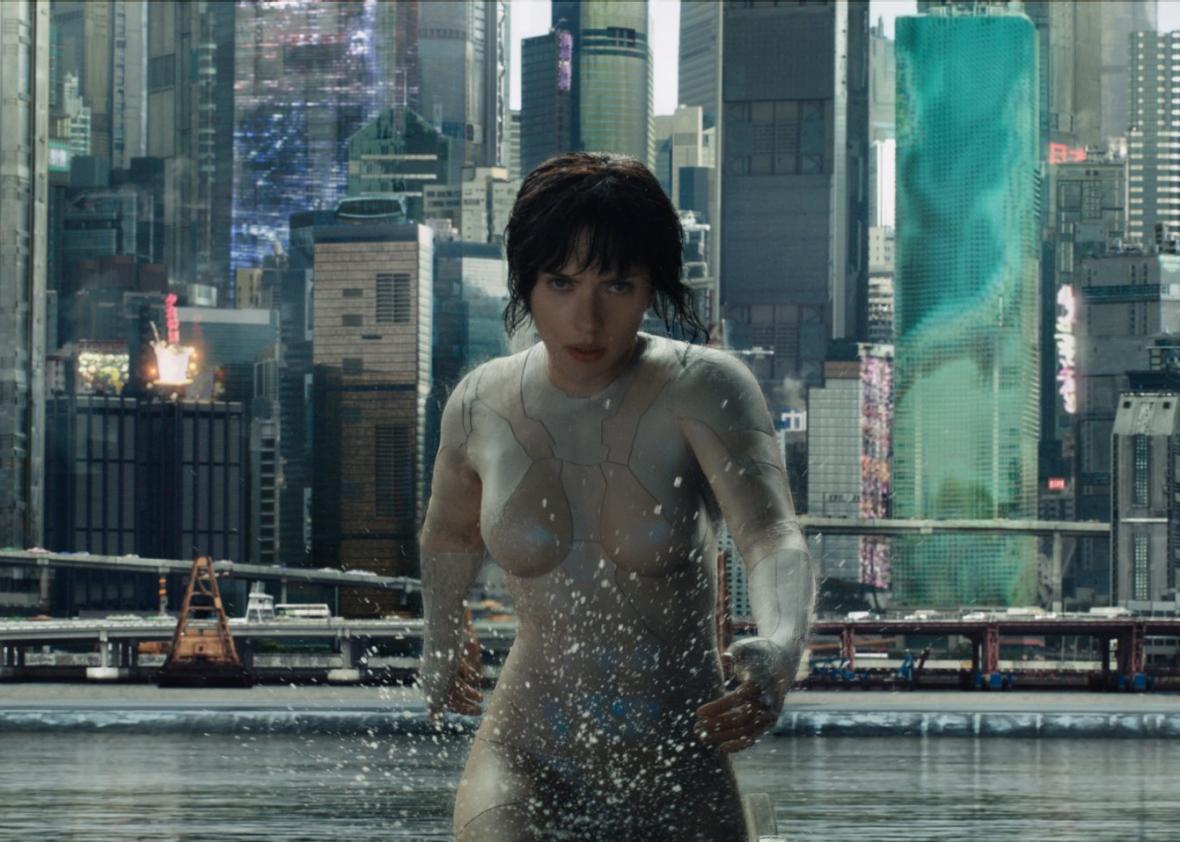Major spoilers ahead.*
Accusations of Hollywood whitewashing have dogged the live-action remake of Ghost in the Shell ever since Scarlett Johansson signed on to take the lead role as cyborg counterterrorism commander “The Major” more than two years ago. In fact, the new film—which joins a wave of other recent movies and TV shows that have faced backlash for casting white people in roles that ostensibly should be played Asian actors—has been so overshadowed by its behind-the-scenes narrative that, before the preview screening I attended in New York, an audience member yelled out “Whitewashing!” in the middle of a publicist’s spiel asking audience members to turn off their cell phones. (The publicist, who appeared to be white, was not happy,and scolded the guy, who was black, like a principal scolds an outspoken teen at a school assembly.)
The facts of the case appeared to be clear-cut and all too familiar: Yet another white actor was cast in a role that was originally conceived as Asian (in an industry that already slights nonwhites in so many ways). And the reports about Paramount running special effects tests to make Johansson appear “more Asian” (reports that Paramount has denied) raised the specter that things could get even worse.
Still, nothing hinted at the remake’s third-act surprise, in which it takes a hard left turn away from the original. The twist: The Major was Japanese all along. Her brain, the film reveals, was transplanted into the body of Scarlett Johansson. This manages to make Ghost in the Shell’s racial politics even more groanworthy (and, judging from the screening I attended, laughable) than previously imagined.
Here’s how it all goes down. At the beginning of the film, we glimpse the procedure that created the Major and are told that after her body was killed in a shipwreck, they were able to save her brain and transplant it into a completely synthetic cyborg “shell,” making her the first of her kind. In the Major’s previous life, we’re told, she was a woman named Mira Killian. When the Major finally meets the mysterious hacker Kuze (Michael Pitt), however, viewers learn that Hanka Robotics, the corporation that commissioned her creation, has been suppressing the memories of her true identity. Eventually, she finds her way back to the doorstep of an older Japanese woman (Kaori Momoi), who lives alone in a tenement building with her cat and a shrine to remind her of her long lost daughter, who was named Motoko Kusanagi. The woman welcomes the Major into her home and dishes on how Motoko was an outspoken opponent of the government’s use of technology and was arrested and killed just a year prior—around the same time the Major was created. (Motoko Kusanagi, of course, was also the Major’s name in the manga and in the 1995 animated version.)
All of this seems to fly in the face of Johansson’s recent comment defending her role, in which she claimed that her character is “identity-less”—a comment that says so much about the idea that whiteness is seen as the default, “the absence of race.”
On the other hand, this conceit could have been fascinating. The idea of Asian “ghosts” being implanted into white “shells” opens the floor for a whole array of interesting questions and possibilities. What effect does this have on the Asian population of this dystopian future—will their racial identity eventually be wiped out? How might a Japanese person who is not yet a cyborg deal with this phenomenon on an emotional and psychological level?
Not to mention: Could there be an allegory here, for the ways in which Asian culture is often mangled for Western consumption, with little regard for the original source? You know, the same kinds of ideas that Get Out explores so brilliantly with (and here comes a spoiler for Get Out) its almost mirror-image plot twist, which features white minds being implanted into nonwhite bodies, instead of the other way around. Interestingly, these respective twists parallel the ways whites view each of these groups: Asians are stereotyped as having powerful brains, while black people are fetishized as having powerful bodies.
But Ghost in the Shell isn’t concerned with any of this, of course. The script completely sidesteps any of the troubling complexities of the big revelation, and all of the actors directly involved with the storyline are left off the hook—Johansson, Pitt, and Momoi have to pretend as though the idea of Japanese brains being stolen by rich white people and placed in white bodies carries no racial implications. In turn, the film lets its audience off the hook from having to think about any of this, either. Instead, we just get a brief shot of Scarlett Johansson staring at a tombstone bearing the real name of her character, Motoko Kusanagi.
Had the film been just a straightforward American remake of a Japanese film, such as, say, the American remake of The Ring, which starred Naomi Watts and took place in the United States, Ghost in the Shell probably wouldn’t feel as troublesome. It might have simply gotten by as a stylish (if unnecessary) remake with some dazzling visual effects and very on-trend costumes. But by wading into such treacherous territory without really grappling with the implications, the film makes its artistic liberties feel cheap and even more infuriating—like a 21st-century, “post-racial” incarnation of yellowface.
